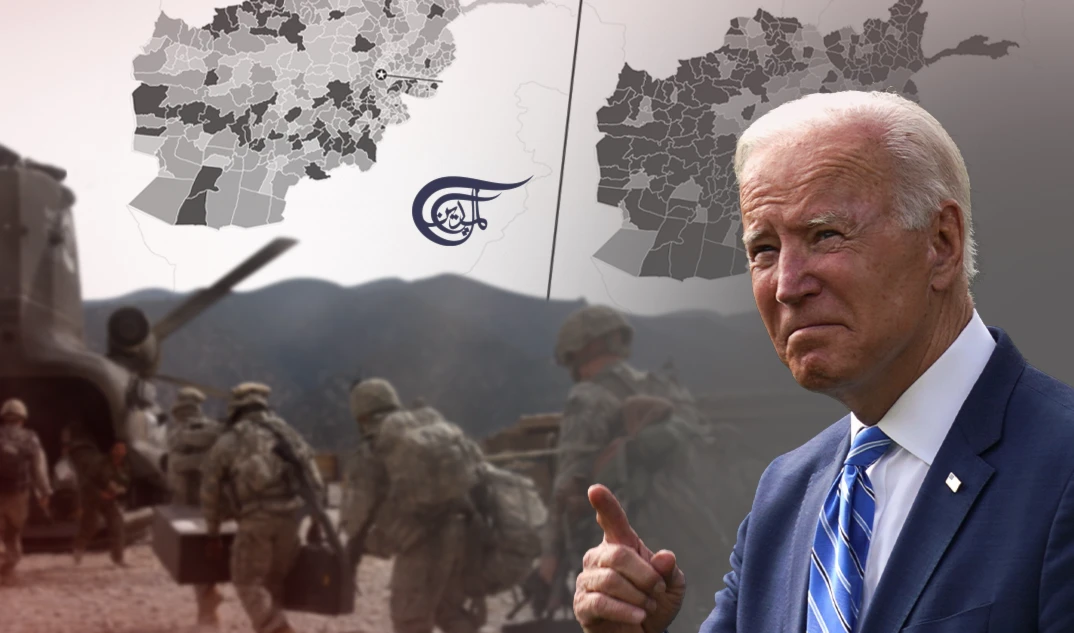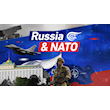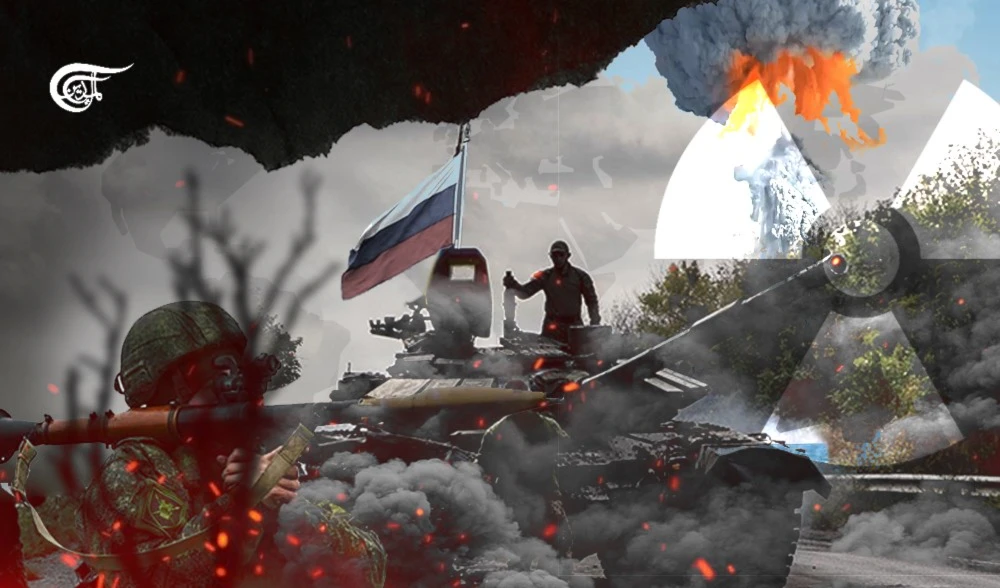Ukraine in the Great Game
Throughout history, Belarus, Ukraine, and Russia were intertwined with a set of solid cultural, political, and economic links, to the point that the division did not appear more than mere administrative under Soviet jurisdiction. But it all changed after the collapse of the Union.
The escalation between the West and Russia
Today, under Joe Biden's neoconservative and ultra-globalist administration, relations between Russia and the United States are so strained that humanity is on the verge not of a Cold War (which has long been ongoing), but of a nuclear war, World War III. The main stumbling block is Ukraine. To foreign observers, the conflict between the two kindred Eastern Slavic Orthodox peoples, who have a common ancestry from Kievan Rus', is something strange and incomprehensible. It suggests itself that a third force has a hand in this conflict - that is, the same Americans, who have tried to set the two brotherly peoples against each other, and by supporting one of the sides - Ukraine - to strike a blow to Russia, which is returning to history thanks to the patriotic reforms of President Putin.
There are several factors in the relationship between Russia and Ukraine that are not entirely obvious to the outside observer.
Ukraine never existed
The first misconception is to present the conflict as a confrontation between two states. The Western press and politicians present everything as if Ukraine is a separate country with its own long history, which Bolsheviks forcibly annexed to the USSR in the 1920s, and when the communist regime collapsed, Ukraine immediately regained its independence. This has nothing to do with reality at all.
Kievan Rus’ and fragmentation: the origins of the three branches of the Eastern Slavs
The Russian state emerged in the ninth century in the north of Russia - in Novgorod, but in a short time, its capital was transferred to Kiev. Hence the name Kievan Rus. Its population consisted mainly of eastern Slavs with a significant percentage of the Finno-Ugric population in the north and northeast and Turkic in the south and southeast.
Quite soon the uniform state was divided into some almost independent areas - Princedoms.
In the west main the principalities were Galicia and Volhyn’.
In the east Vladimir (later Moscow) began to gain power.
In the northwest, the Principality of Polotsk came under Lithuanian influence and became the basis of the Grand Duchy of Lithuania.
Russian East and Russian West
Between the east and west of Russia in the Middle Ages, there was a tense opposition for a grand-ducal throne, which Vladimir’s princes finally managed to seize. Under Andrei Bogolyubsky (XII) the capital of all Rus’ was moved to Vladimir, and later the capital of the great princes became the residence of Moscow, located in the east of Rus’. Kiev was abandoned and almost forgotten living only in legend.
That's when in the epoch of fragmentation in the XII century the united people of Kievan Rus’ - east Slavs - split up into three branches - southwest, northwest, and east. Later they were called, respectively, Malorossy (Little Russians or Ukrainians), Byelorussy (White Russians), and Velikorossy (Great Russians, the east of Russia was called Velikorossia, Great Russia).
Their fates were different. During the Mongol invasion, Velikorossy and Malorossy have entered under the authority of Mongolian khans, but Velikorossy under the direction of the great Princes recognized by the Horde, have conserved full-scale Orthodox Christianity (with Metropolitan at the head of Church) and a certain degree of sovereignty. The Little Russians (Malorossy), on the other hand, found themselves divided between Lithuania, Poland, and Austro-Hungaria, and their religious identity was strongly influenced by Western Catholicism. The Belorussy (White Russians), on the other hand, became part of the Grand Duchy of Lithuania, which was relatively independent from the Golden Horde.
Rise of Velikorossia (Great Russia)
As the centuries passed and after the fall of the Golden Horde, Moscow began to turn into a powerful regional power. Lithuania was united with Poland and came under the authority of the Catholics. And the Little Russians (aka Ukrainians) found themselves in the position of subordinate classes, partly under the Poles, partly as part of the Austro-Hungarian Empire. The southern regions of the former Kievan Rus’ first came under the rule of the Crimean Tatars, and then have annexed together with Crimea by the Ottoman (Turkish) Empire. Hence the name Ukraine, i.e., Okraina, what means “a peripheral territory” without any independence and divided between different states. At the same time, the nucleus of Little Russians (Ukrainians) preserved Orthodoxy and the old East Slavic traditions.
As Moscow's power grew, the Velikorossy (Great Russians) began to force the Poles and the Turks, seizing their possessions in the former Kievan Rus' space and adding them to their growing Empire. First of all the lands of Novorossia (New Russia) from Kharkov to Odessa and finally Crimea was conquered from the Ottoman Empire. These territories were populated either by natives of Great Russia or by Moscow-friendly Cossacks, both of Little Russia (Ukraine) and those that had spread to the south of the Russian Empire itself. Novorossia (New Russia) became an integral part of the Russian Empire. Later, other regions of Ukraine, this time populated primarily by the Ukrainians themselves and the Malorussian Cossacks, were also recaptured from the Poles. The same happened in the northwest with Belorussia. These lands also became part of the Russian Tsarist Empire.
The breakup of the Empire
The breakup of the Russian Empire in 1917-1921 led to various nations declaring independence from Moscow. But the Bolsheviks gradually returned most of the territories - except Poland, Finland, and the three Baltic republics - to Moscow's power (Baltic states were reintegrated later by Stalin after WWII). Ukraine and Belorussia in completely arbitrary and purely administrative boundaries became an integral part of the USSR. The USSR was created from above as a unitary state with a communist ideology. Prior to the Soviet Union, neither Ukraine nor Belorussia existed as separate States, unless you consider the medieval principality of Galicia-Volhynia and Polotsk.
The collapse of the Soviet Union
When the USSR collapsed in 1991, the ex-Soviet Union Republics, and in fact, all the same administrative provinces of the Russian Empire, called "republics" in the Soviet period, declared their independence from Moscow under the influence of corrupt elites and with the direct support of the capitalist West. Since the same kind of pro-Western reformers were in charge in Moscow starting with Yeltsin and in the 90's, they easily recognized the new entities within the very - completely artificial - borders they had in the USSR. In the USSR, the borders themselves had no meaning and were drawn only for the convenience of administrative management (as districts of one and the same city).
So in place of the single State of the USSR, which emerged in place of another single State of the Russian Empire, that gathered all these lands and peoples together, there were 17 new - almost never existed - at least in such borders, and most of them did not exist at all – “States” (failed from the very birth). Some of them remained loyal to Moscow. Another fell under the influence of the West and took a harshly anti-Russian line. Alas, Ukraine belongs to this second category.
Two Ukrainians (or more)
The territory of the new political entity "Ukraine," which emerged in 1991, consists of completely heterogeneous territories and peoples.
Eastern Ukraine (from Odessa to Kharkov through the Donbass) or Novorossia is populated by virtually the same people as the southeast of modern Russia. These lands, as we have seen, were taken from the Turks by the Russian Empire (much of it under Catherine the Great) and repopulated by Russians (Great Russians, Velikorossy). The same applies to Crimea.
The western regions of Ukraine -- right-bank Ukraine, if you look at the map along the Dnieper River -- had been under Catholic Polish and Austro-Hungarian rule for many centuries and had no statehood at all. Being Orthodox and predominantly peasants, they were considered by the Catholic nobility as inferior people. However, not all of them were happy to meet Great Russians as liberators. Part of Little Russians (Ukrainians) tried to assert their identity, of course, different from the culture of the Moscow Tsardom and the Great Russian Empire. It was from such dissenters that Ukrainian nationalism and even the Ukrainian language itself began to be formed under the strong influence of Poles and the West in general - an artificial construct based on various dialects of South-Eastern dialects, imitating the structure of the Polish language. The first signs of such artificially constructed nationalism praising purely imaginary “Ukrainian identity” can be seen in the early twentieth century under the Russian Empire. During the Second World War, many Ukrainian nationalists (Bandera, Shukhevich, etc.) joined Hitler. They had particularly brutal massacres of Communists, Jews, Poles, and Great Russians to their credit. This part is known collectively as the zapadentsy (from “Zapad” – “West” in Russian and in Ukrainian).
In the far West of Ukraine live the Ruthenians, another branch of the Eastern Slavs with a very different identity from the zapadentsy.
Nezalezhnost' (independence) as a concept of the zapadentsy
The independence of Ukraine was the slogan of the zapadentsy, while the inhabitants of the East saw nothing wrong in maintaining close contact with Russia, as they represented the same people with Russians in general. By the way, the Russian (Velikorossky) language is spoken by the vast majority of Ukrainians. The artificial Ukrainian language was known to only a few people and was used in everyday speech by a few. Nevertheless, this zapadentsy’s line prevailed in Ukraine in the 1990s, and they occupied key positions in politics, economics, culture, and information. The West actively supported such zapadentsy’s nationalism, despite its Nazi history and racist ideology. U.S. and NATO strategists decided pragmatically to use these forces in Ukraine to tear the entire country away from Russia and put it under full Western control in the future.
Ukrainian East vs. Ukrainian West
Throughout the new Ukraine, two tendencies, the western and the eastern, have been battling each other. It can be seen in the electoral maps - the pro-Moscow east voted for some candidates and the pro-Western, Russophobic West always for alternatives. The presidents succeeded each other, and their course represented a swing between Moscow and Washington. Kravchuk was a moderate Westerner. Kuchma took a multi-vector stance. Yushchenko leaned unequivocally toward the West. Yanukovich - inconsistently and hesitantly - sought support from Moscow. But all the while, Western trends continued to grow in politics and culture, to the point of calling for the genocide of the population of Crimea and the Ukrainian East in general, which, according to the nationalists, was loyal to Moscow.
The Maidan, actively supported by the U.S. - the same Biden, Victoria Nuland, and the neocons - brought the most radical zapadentsy to power in the coup d'état that toppled Yanukovich. Half of Ukraine was under a real threat of mass terror. The junta that came to power declared its NATO orientation and demanded the withdrawal of Russian ships from Sevastopol.
Putin comes into play
It was at this point that Moscow - no longer the same as it was under Yeltsin, but a new sovereign and clearly aware of its geopolitical interests - Putin's Moscow decided to intervene. The population of Crimea, which happened to be part of Ukraine by accident, immediately declared its unification with Russia. The regions of Donbass - Donetsk and Lugansk - made the same decision. Odessa, Kharkiv, and Mykolaiv would have done the same, - perhaps Poltava and Sumy, - but the zapadentsy in Kiev turned to mass repressions (the murder of civilians in Odessa in the House of Trade Unions on May 2, 2014, etc.).
After several attempts to reclaim the Donbass, Kiev abandoned this strategy and began to prepare for a closer alliance with the West and NATO. At this point, Putin made a mistake: he recognized Ukraine's new government in the hope of establishing peace with Kiev.
Minsk deadlock
This is the situation that we have at the moment. The Norman format and the Minsk agreements, in fact, are aimed only at de-escalation, but in the long term and even in the medium term do not solve anything.
There can only be one solution to this situation: the division of Ukraine into two parts, with recognition of the political sovereignty of both halves - Western Right-Bank Ukraine and Novorossiya, with a special status for Kyiv. Sooner or later this will happen. As sooner or later mainland China and Taiwan will be united within one state.
The US is escalating
Since in the White House with the arrival of Biden, there was a group of extreme globalists, Atlanticists, neocons, and supporters of saving a unipolar world at any price, in fact, the same ones who provoked the Maidan in 2013-2014, a new round of escalation began. Russia is accused of preparing for an invasion of Ukraine, under this pretext in reality is going to accelerate the integration of Ukraine into NATO. Moscow has not the slightest intention of solving the situation by military means, but U.S. provocations leave Moscow no choice, as Putin, Lavrov, and other top Russian officials have repeatedly stated recently. Putin has declared Ukraine's integration into NATO - along with the half of the population that generally considers itself one people with the Russians - a crossing of a "red line." If the West fails to heed this warning, a military conflict cannot be ruled out.
It is necessary only to understand that it is not about an attack of one country on another, but about the processes of the big geopolitics. When Moscow was weak and ruled either by idiots or direct agents of Western influence, Russia has lost Ukraine, which fell into the hands of extremist nationalist politicians immediately picked up by the West. When Putin began to restore Russia's sovereignty and power as a great power, Ukrainian issues came to the fore. Zbigniew Brzezinski was convinced that without Ukraine, Russia could not become the sovereign pole of a multipolar world. He would have been right. Russia today has set a firm course for becoming such a pole.
The attentive reader can draw the rest of the conclusions himself.

 Alexander Dugin
Alexander Dugin
 13 Min Read
13 Min Read












